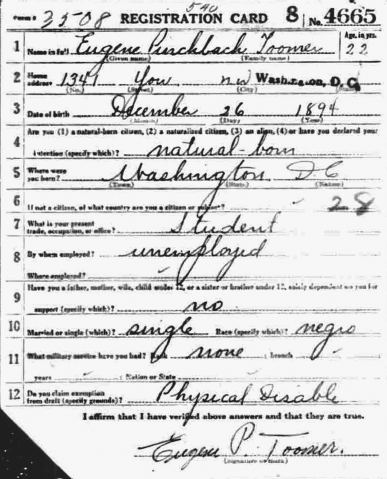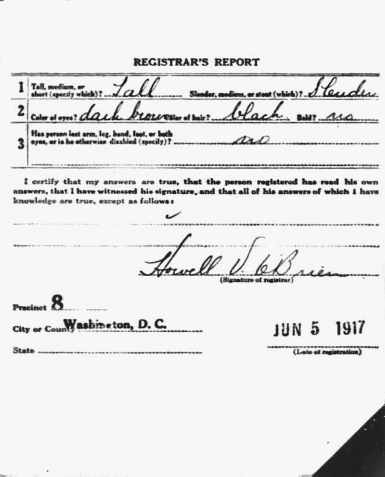Cane (22 page)
Authors: Jean Toomer
As Toomer passed into Gurdjief’s world, he passed into literary obscurity. While his search for enlightenment or the “intelligible scheme” took him to India, through Jungian analysis, and to his conversion to the Society of Friends, Toomer’s commitment to Gurdjief, while fluctuating in its intensity, nevertheless remained the organizing principle of his life. He recommitted himself to this work in 1953, and remained a disciple until he passed away on March 30, 1967—the year in which the third edition of
Cane
was published.
Jean Toomer’s Racial Self-Identifcation:
A Note on the Newly Found Documents
Of course, we are still confronted with the vital question that has arisen in various ways throughout this introduction: Was Jean Toomer a Negro who passed for white?
Thanks to pioneering research conducted at the editors’ request by the genealogist Megan Smolenyak Smolenyak, we can now understand more fully than ever before Jean Toomer’s conflicted thinking about his racial identification, as he expressed them in public documents, including the federal census, two draft registrations, and on his marriage license to Margery Latimer. In addition, we also now know how Toomer’s grandfather and grandmother, Pinckney Benton Stewart Pinchback and Nina Emily Hethorn, his mother, Nina Pinchback, and his father, Nathan Toomer, are all identified in federal census records.
In every census taken between 1850 and 1920, P. B. S. Pinchback and Nina Emily Hethorn are identified either as black or as mulattos. Between 1870 and her death in 1909, Nina Pinchback is identified as a mulatto or black. Likewise, Nathan Toomer is identified between 1870 and 1900 as either mulatto or black. (Nathan’s previous wife, Amanda America Dixon, is also identifed as a mulatto in the 1870 and 1880 censuses and as black on her marriage license with Nathan. Amanda’s mother, Julia Frances Lewis Dixon, is also identified in the censuses taken between 1870 and 1910 as a mulatto or black.) In other words, Jean Toomer’s mother, father, grandfather, and grandmother all self-identified as Negroes.
In the 1900 federal census, Eugene Toomer is listed as black. In the 1910 federal census he is listed as mulatto. In June 1917, Eugene Pinchback Toomer registered for the draft in Washington, D.C. He is recorded to be an unemployed student, single, as having an unspecified disability, and as being a “Negro.” According to Kernan and Eldridge, the “unspecified disability” was actually “bad eyes and a hernia gotten in a basketball game.”
154
The 1920 United States Federal Census shows Toomer boarding with other lodgers in the home of an Italian couple on East Ninth Street in Manhattan. He is assigned New York as a birthplace, suggesting that someone else responded on his behalf, in his absence. His race is listed as “white.”
In the 1930 United States Federal Census, Toomer is listed as a resident, with many others, at 11 Fifth Avenue, in Manhattan. Because of the accuracy of the other data contained in this document—including his birthplace, his parents’ states of birth, and his occupation as a freelance writer—it is likely that he furnished these details himself. His race is listed as white.
A year later Toomer married “Marjery” or Margery Latimer on October 30, 1931, in Portage, Wisconsin. Both the bride and the groom are identified as “white” on the marriage license. According to Kerman and Eldridge, Margery Latimer was aware of what she terms “the racial thing,” that is, that Toomer was black.
155
Though this is true and though she shared Toomer’s vision of a new race in America, she was nevertheless unprepared for headlines such as this one published in the national press regarding her marriage to Toomer: “Negro Who Wed White Writer Sees New Race.”
156
While Toomer proclaimed that his marriage to Margery Latimer was evidence of a “new race in America…, neither white nor black nor in-between,” and that their marriage was simply one between “two Americans,” the white press chose to focus upon only the most sensational aspects of their nuptials.
157
In 1942, Toomer registered once again for the draft, as part of the World War II Draft Registration. He identified himself as Nathan Jean Toomer, and he was living with his second wife, Marjorie C. Toomer, in Doylestown, Pennsylvania. He is described as 5’10” tall, weighing 178 pounds, with black hair and eyes, and a “dark brown complexion.” He identified himself as a “Negro.”
These documents reveal that Jean Toomer self-identified as Negro in 1917, when he first registered for the draft. Then either he or a roommate decided to identify him as “white” in the federal census of 1920. Similarly, Toomer self-identified as “white” in the 1930 census and a year later on his marriage license with Margery Latimer. He then self-identified again as a Negro in 1942 on his second draft registration. Given the fact that draft boards at the time were local, Toomer’s decision to identify himself as a black man is quite surprising. Since the draft board would have been unaware of Toomer’s previous identification of himself as a Negro in 1917, we are left wondering why he did this after he had decided to pass as a white man.
In the course of the twenty-five years between his 1917 and 1942 army registrations, Toomer was endlessly deconstructing his Negro ancestry. We recall that during his childhood and adolescence in Washington, D.C., and New York, Toomer lived in both the white and the black worlds, and here we must emphasize the fact that during his adolescence he was educated and lived in the world occupied by Washington’s black and mulatto elite. Based upon his experiences in this special world “midway between the white and Negro worlds,”
158
Toomer claimed that he developed his famous “racial position” in 1914, when he says he first defined himself as an “American, neither white nor black,” just a year after declaring himself to be a Negro in his first draft registration. But given the fact that his parents and grandparents identified themselves and Toomer (in the 1900 and 1910 federal censuses) as black, it is apparent that Toomer’s feelings about his racial identity were anomalous within his own family.”
159
It is important to stress that the first short story Toomer ever wrote, “Bona and Paul,” composed in 1918, takes passing as its central theme, and that this deeply autobiographical story reflects Toomer’s early preoccupation with his racial identity.
Equally important, Toomer’s assertion that “Kabnis is me,” in his well-known December 1922 letter to Waldo Frank concerning his relationship to a character of mixed-race ancestry who is deeply conflicted about his Negro ancestry, is further evidence of his ambivalence regarding his racial identity. This ambivalence about his black ancestry is also reflected in the controversial launch of
Cane
, specifically his conflicted, indeed angry reaction to Waldo Frank’s introduction, and later his refusal to cooperate with Horace Liveright, his publisher, in “featuring Negro” in the marketing of
Cane
in the fall of 1923. Indeed, he all but said to Liveright: “I was not a Negro.”
160
According to Darwin Turner, Toomer, in his correspondence with the writer Sherwood Anderson just a year before the publication of
Cane
, “never opposed Anderson’s obvious assumption that he was ‘Negro.’ In fact, Anderson began the correspondence because Toomer had been identified to him as a ‘Negro.’”
161
Toomer’s contradictory stance vis-à-vis Liveright and Anderson reveals the depth of his anguish about his race in the weeks before the publication of the work that would link him to a literary tradition from which he would fee.
We also must recall Toomer’s anger with Alain Locke for reprinting excerpts of
Cane
in
The New Negro
in 1925 (he was silent regarding Locke’s decision to reprint “Song of the Son” in the 1925 Harlem issue of
The Survey Graphic
), a reaction that smacks of denial and ingratitude, given Locke’s early and consistent support of Toomer while he was still living in Washington, D.C. And then in 1934, almost ten years after the publication of
The New Negro
, Toomer, most improbably, observes to the
Baltimore Afro-American
newspaper that “I have not lived as [a Negro] nor do I really know whether there is colored blood in me or not.”
162
During this same period, Toomer refuses to contribute to Nancy Cunard’s anthology
The Negro
(1934) stating that “though I am interested in and deeply value the Negro, I am not a Negro.”
163
This claim stands out as particularly disingenuous when we recall Toomer’s week-long trip with Waldo Frank in the fall of 1922 in Spartanburg, South Carolina, where they masqueraded as “blood brothers,” that is, as Negroes.
164
After serving as Frank’s “host in a black world,”
165
Toomer returned to Washington, and for two weeks worked as an assistant to the manager of the Howard Theater, a theater that served the capital’s African American community, and where he gathered material for such stories as “Box Seat” and “Theater.” These shaping experiences in the black world, among many others, call into question Toomer’s odd claim in the
Baltimore Afro-American and to the anthologist Nancy Cunard that he was not, and had not been, black.
At this juncture, it is useful to return to Elizabeth Alexander’s “Toomer,” the splendid poem that opens our introduction and that also evokes Toomer’s shifting, complex, contradictory stance on race: “I wished / to contemplate who I was beyond / my body, this container of flesh. / I made up a language in which to exist. /…Oh, / to be a Negro is—is? / to be a Negro, is. To be.”
166
Alexander’s key line is this: “I made up a language in which to exist.” In this insightful line, Alexander captures not only Toomer’s definition of race as a social construction, but also his anguished effort to liberate himself from his apparent anxiety and ambivalence about his black ancestry.
Not withstanding Toomer’s definition of himself as an “American, neither white nor black,”
167
at crucial stages in his life he self-identified as Negro: as a young adult in 1917 at the age of 23, Toomer self-identified as Negro; again in 1942 as a mature adult at the age of 48, Toomer self-identified as Negro. While the registration cards, the census data, and marriage certificate are contradictory, there is, nevertheless, a pattern. It is our carefully considered judgment, based upon an analysis of archival evidence previously overlooked by other scholars, that Jean Toomer—for all of his pioneering theorizing about what today we might call a multicultural or mixed-raced ancestry—was a Negro who decided to pass for white. Here we respectfully disagree with Toomer’s biographers Kerman and Eldridge, who claim that Toomer never attempted “to ‘pass’ in a racial sense.”
168
And what is Toomer’s relationship to American modernism and the African American literary tradition? Without question,
Cane
is a classic work of timeless significance in American and African American letters. In its pages we encounter again and again the arresting vision of an astonishingly original writer. And what shall be our generation’s relationship to this great artist of the Harlem Renaissance and the Lost Generation, who rejected the very book by which he is destined to be remembered? Alice Walker expressed a perspective we would do well to reflect upon. Shortly after the publication of
Meridian
, her magisterial fictional meditation on the civil rights movement, and her own formal response to Toomer’s call in
Cane
, Walker concluded: “I think Jean Toomer would want us to keep [
Cane
’s] beauty, but let him go.”
169
Walker is probably correct in her assessment of Toomer’s own wishes. However, since Toomer’s
Cane
is arguably the most sophisticated work of literature created over the course of the Harlem Renaissance, we imagine that future generations of scholars will find his struggle with his racial identity as endlessly fascinating as we have.

Toomer’s draft registration, June 5, 1917.
